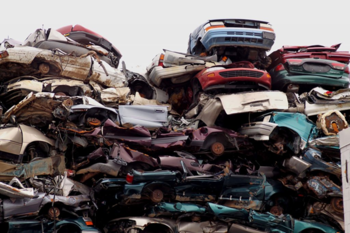End-of-Life Vehicles: Difference between revisions
add pic |
m add categories |
||
| (3 intermediate revisions by 2 users not shown) | |||
| Line 1: | Line 1: | ||
[[Category:Tonnage & Waste Types]] | [[Category:Tonnage & Waste Types]][[Category:Targets & Metrics]] | ||
The introduction of the [[End of Life Vehicle Regulations 2003 (as | The introduction of the [[End of Life Vehicle Regulations 2003 (as amended)]] (ELVR2003) means that every year 2 million [[End-of-Life Vehicles]] ([[ELV]]) will be processed to ensure that potential pollutants such as fuel, oils, brake fluids and other liquids are removed, collected and stored<ref>https://www.hse.gov.uk/waste/dismantling.htm</ref> as part of a decommissioning process. These wastes are ultimately [[treatment|treated]] or [[disposal|disposed]] of, with the decommissioned vehicle shredded to produce [[Automotive Shredder Residue]] for subsequent [[recycling ]] and [[recovery]]. | ||
[[File:Scrap Car Pic - Junkyard.png|350px|left|Scrap Cars - Trinomics all rights reserved]] | [[File:Scrap Car Pic - Junkyard.png|350px|left|Scrap Cars - Trinomics all rights reserved]] | ||
<br clear='left'/> | <br clear='left'/> | ||
==Overview== | ==Overview== | ||
[[End-of-Life Vehicles]] are regulated to limit the environmental impact of their [[disposal]] by reducing the amount of waste when they are scrapped. The [[EWC]] codes prefixed 16 01 ([[EWCChap16|16 01 03 to 16 01 99]]) capture the waste from [[End-of-Life Vehicles]]. The [[End of Life Vehicle Regulations 2003 (as amended)]] and the [[End of Life Vehicle (Producer Responsibility) Regulations 2005 (as amended)]] are the underpinning legislation applying to all cars with up to 9 seats and small vans of up to 3.5 tonnes<ref>https://www.gov.uk/guidance/elv</ref>. ELVs are classified as [[Hazardous Waste|hazardous waste]] in England and Wales and [[Special Waste|special waste]] in Scotland until depolluted and must be processed via an [[Authorised Treatment Facility]] ([[ATF]]). | [[End-of-Life Vehicles]] are regulated to limit the environmental impact of their [[disposal]] by reducing the amount of waste when they are scrapped. The [[EWC]] codes prefixed 16 01 ([[EWCChap16|16 01 03 to 16 01 99]]) capture the waste from [[End-of-Life Vehicles]]. The [[End of Life Vehicle Regulations 2003 (as amended)]] and the [[End of Life Vehicle (Producer Responsibility) Regulations 2005 (as amended)]] are the underpinning legislation applying to all cars with up to 9 seats and small vans of up to 3.5 tonnes<ref>https://www.gov.uk/guidance/elv</ref>. ELVs are classified as [[Hazardous Waste|hazardous waste]] in England and Wales and [[Special Waste|special waste]] in Scotland until depolluted and must be processed via an [[Authorised Treatment Facility]] ([[ATF]]). A list of all licensed [[ATF|ATFs]] in England can be found at: https://www.gov.uk/find-vehicle-scrapyard | ||
Producers must meet annual [[recycling]] and [[recovery]] targets for their brands, currently 95% [[recovery]] and 85% [[recycling]]. The [[Office for Product Safety and Standards]] ([[OPSS]]) has been appointed by [[DEFRA]] to enforce the regulations and their most recent guidance was published in February 2021<ref>https://assets.publishing.service.gov.uk/government/uploads/system/uploads/attachment_data/file/966612/opss-elv-leaflet-2021.pdf</ref> | Producers must meet annual [[recycling]] and [[recovery]] targets for their brands, currently 95% [[recovery]] and 85% [[recycling]]. The [[Office for Product Safety and Standards]] ([[OPSS]]) has been appointed by [[DEFRA]] to enforce the regulations and their most recent guidance was published in February 2021<ref>https://assets.publishing.service.gov.uk/government/uploads/system/uploads/attachment_data/file/966612/opss-elv-leaflet-2021.pdf</ref> | ||
==References== | ==References== | ||
Latest revision as of 13:16, 7 June 2022
The introduction of the End of Life Vehicle Regulations 2003 (as amended) (ELVR2003) means that every year 2 million End-of-Life Vehicles (ELV) will be processed to ensure that potential pollutants such as fuel, oils, brake fluids and other liquids are removed, collected and stored[1] as part of a decommissioning process. These wastes are ultimately treated or disposed of, with the decommissioned vehicle shredded to produce Automotive Shredder Residue for subsequent recycling and recovery.

Overview
End-of-Life Vehicles are regulated to limit the environmental impact of their disposal by reducing the amount of waste when they are scrapped. The EWC codes prefixed 16 01 (16 01 03 to 16 01 99) capture the waste from End-of-Life Vehicles. The End of Life Vehicle Regulations 2003 (as amended) and the End of Life Vehicle (Producer Responsibility) Regulations 2005 (as amended) are the underpinning legislation applying to all cars with up to 9 seats and small vans of up to 3.5 tonnes[2]. ELVs are classified as hazardous waste in England and Wales and special waste in Scotland until depolluted and must be processed via an Authorised Treatment Facility (ATF). A list of all licensed ATFs in England can be found at: https://www.gov.uk/find-vehicle-scrapyard
Producers must meet annual recycling and recovery targets for their brands, currently 95% recovery and 85% recycling. The Office for Product Safety and Standards (OPSS) has been appointed by DEFRA to enforce the regulations and their most recent guidance was published in February 2021[3]
